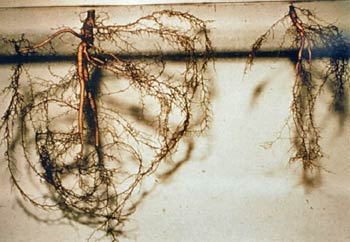There are a limited number of plant species worldwide that are independent of mycorrhizae (see Table 1). However, most plants rely on their symbiotic relationship with mycorrhizae to more or lesser degrees for improved nutrient uptake and resistance to disease, drought, and frost symptoms. (Kottke 2002) Plant health and planting success depend, in part, on the health of the mycorrhizal community. Projects designed to maintain or improve mycorrhizal health are more likely to be sustainable and establish healthy, long-lived plantings.
Currently, a number of management practices are used to maintain or establish mycorrhizal communities within disturbed or denuded soils:
-
Stockpiling native topsoil: Native topsoil is an important natural resource that contains a diverse fungal community that is essential for plant health. If topsoil must be disturbed, it should be stockpiled onsite for use after projects are completed. Different methods for stockpiling soil can either maintain microbial health or destroy the fungi community. Sustainable practices should be used when storing topsoil. (See “Construction and Siting Issues”)
-
Inoculation: Some projects use commercially available mycorrhizal spores to “inoculate” plantings. Attention should be given to the species of mycorrhizal spores used for inoculation given the associated plant community. (See “Cost Issues”)

- Importation: In some cases, mycorrhizal spores can be “imported” from areas adjacent to the construction site and used in planting areas. In other projects, stockpiling the native topsoil and/or maintaining a viable mycorrhizal community in native soil is not realistic. In these instances, topsoil with a healthy rhizosphere community may be imported and used on site, but is not necessarily a sustainable landscape practice. (See “Cost Issues”) Norman et. al. (1997) have noted a study by Allen and Friese (1992) that used inoculated trees and shrubs as well as “live soil” throughout an area of sterile soil to regenerate the microbial community. Microbes spread throughout the soil within a few weeks to a few months.
|


